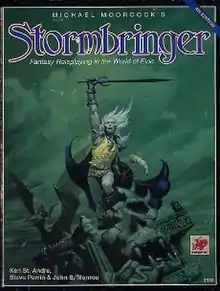| Fantasy Roleplaying in the World of Elric | |
|---|---|
 4th edition box cover illustrated by Michael Whelan, 1977. | |
| Designers |
|
| Publishers | |
| Publication |
|
| Genres | Fantasy |
| Systems | Basic Role-Playing |
Stormbringer is a fantasy tabletop role-playing game published under license by Chaosium. Based on the Elric of Melniboné books by Michael Moorcock, the game takes its name from Elric's sword, Stormbringer (though one edition was published as Elric!). The rules are based on Chaosium's percentile-dice-based Basic Role-Playing system.[1]
System
The game uses a variant of Chaosium's Basic Roleplaying, with its own rules for magic and other setting-specific elements. The first three editions are functionally similar, while the fourth edition changed the magic system extensively. Elric! was a substantial reworking of the game, and Stormbringer fifth edition consists of the Elric! rules with additional material from several older, out-of-print supplements incorporated.
History
Chaosium had already published a boardgame based on Moorcock's Elric of Melniboné series, called Elric in 1977. There have been several editions of the tabletop role-playing game:
- 1st edition (1981) by Ken St. Andre and Steve Perrin; boxed set
- 2nd edition (1985) by St. Andre; boxed set
- 3rd edition (1987) by St. Andre, published jointly with Games Workshop
- 4th edition (1990) by St. Andre, Steve Perrin, and John B. Monroe; boxed set
- Elric! (1993) by Lynn Willis, Richard Watts, Mark Morrison, Jimmie W. Pursell Jr., Sam Shirley, and Joshua Shaw.
- 5th edition (2001) by Lynn Willis
In 2007 Chaosium dropped their Eternal Champion license, and it was picked up by Mongoose Publishing. In August 2007, they published Elric of Melniboné by Lawrence Whittaker, which is based on Moongoose's first edition of RuneQuest.[2] A second edition by Lawrence Whittaker and Pete Nash was published in 2010, based on Mongoose's second edition of Runequest.[3] This was discontinued when Mongoose lost the RuneQuest license in 2011.[4]: 116–117
Publications
- Stormbringer Companion (1983)
- Black Sword (1985)
- Demon Magic: The Second Stormbringer Companion (1985)
- The Octagon of Chaos (1986)
- Stealer of Souls (1986)
- The Shattered Isle (1987)
- White Wolf: Temples, Demons, & Ships of War (1987)
Reception
In the February–March 1982 edition of White Dwarf (Issue #29), Murray Writtle gave it an average overall rating of 7 out of 10, and stated that "So, if you want to have single death or glory adventures in the Young Kingdoms, Stormbringer will give you them, but to get a continuing campaign underway will take a certain amount of rewriting and careful thought."[5]
In the January–February 1985 edition of Different Worlds (Issue #38), Keith Herber gave it a top rating of 4 stars out of 4, saying, "I thought Stormbringer not only an excellent adaptation of the Elric series but also found it an extremely enjoyable game. If you have ever read an Elric book (or one of Moorcock's related novels) and wished it could be a game, this is it. If you haven't read one yet do so and then consider the game. You may not find the "doomed" atmosphere to your liking, but around this neighborhood there is a growing movement for a permanent Stormbringer campaign."[6]
In the August 1987 edition of White Dwarf (Issue #92), Jim Bambra called the percentile-based skill resolution system "quick and simple to play." He also liked the experience system, calling it "simple and easy to use with no unwieldy book-keeping required between game sessions." He concluded with a strong recommendation, saying, "Come and enter the world of Elric, you won't be disappointed."[7]
In his 1990 book The Complete Guide to Role-Playing Games, game critic Rick Swan commented, "The bloodthirsty cultists, brutish slave owners, and slovenly drug takers of the Young Kingdoms are a far cry from the friendly wizards and adorable elves populating most other fantasy settings, and designers Ken St. Andre and Steve Perrin have done a chillingly effective job of bringing it all to life." Swan especially liked the magic system, as well as the rules around plant lore, but warned "This is not a game for beginners; the rules presume familiarity with role-playing." Swan concluded by giving this game an excellent rating of 3.5 out of 4, saying, "Sophisticated players, particularly those familiar with the Moorcock novels, should find Stormbringer to be an exceptionally rich and entertaining experience."[8]
In a 1996 poll of readers conducted by the British games magazine Arcane to determine the 50 most popular roleplaying games of all time, Stormbringer was ranked 25th. Editor Paul Pettengale commented: "A simplified RuneQuest, only set in Elric's world. It captures the spirit of the books, but to play it properly you really need to be familiar with the novels, and they are of the type of fantasy that you either love or loathe."[9]
See also
References
- ↑ Writtle, Murray (February–March 1982). "Open Box: Stormbringer". White Dwarf (review). Games Workshop (29): 15. ISSN 0265-8712.
- ↑ Whitaker, Lawrence; Dembski-Bowden, Aaron (2007). Elric of Melniboné. ISBN 978-1-905850-13-6.
- ↑ Whitaker, Lawrence (2010). Elric of Melnibone. ISBN 978-1907218705.
- ↑ Appelcline, Shannon (2014). Designers & Dragons. '00-'09 : A history of the roleplaying game industry (2nd ed.). Silver Springs, MD, USA: Evil Hat Productions. ISBN 978-1-61317-081-6.
- ↑ Writtle, Murray (February–March 1982). "Open Box". White Dwarf. No. 29. Games Workshop. p. 15.
- ↑ Herber, Keith (January–February 1985). "Game Reviews". Different Worlds. Chaosium (38): 30–31.
- ↑ Bambra, Jim (August 1987). "Open Box". White Dwarf. Games Workshop (92): 2.
- ↑ Swan, Rick (1990). The Complete Guide to Role-Playing Games. New York: St. Martin's Press. pp. 197–198.
- ↑ Pettengale, Paul (Christmas 1996). "Arcane Presents the Top 50 Roleplaying Games 1996". Arcane. Future Publishing (14): 25–35.
External links
- Stormbringer! – a website supporting all editions of the Stormbringer RPG